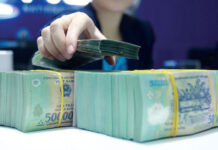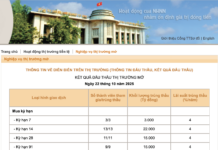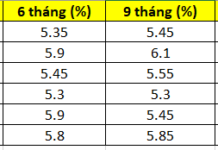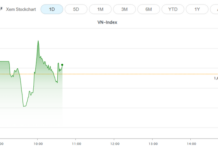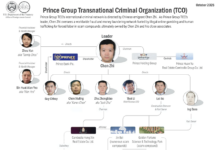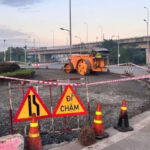Compressing a 3-4 Year Project Preparation into 6 Months
At the Ministry of Transport’s (MOT) monthly task deployment conference for November and key tasks for December 2024, Mr. Luu Quang Thin, Deputy Director of the Planning and Investment Department, shared that based on the registered demands of investors and Project Management Units (PMUs), the MOT has formulated a public investment plan for 2025 with a capital requirement of approximately VND 89,211 billion.

Drilling works for a section of the North-South Expressway Eastern Cluster project phase 2021-2025.
Mr. Thin emphasized, “2025 is an exceptionally important year as it marks the final year to accomplish the goals set by the 13th National Party Congress. We aim to put into operation nearly 1,000km of expressways and prepare for the investment in several large-scale projects, including the high-speed railway and the railway connecting to China, within a very tight timeframe. This will be amidst changes in organizational structure and leadership.”
To accomplish the disbursement goals for 2025, the Planning and Investment Department is collaborating with investors and PMUs to advise the Minister on allocating the 2025 plan for these projects before December 31, 2024.
The Planning and Investment Department instructs investors and PMUs to formulate detailed monthly and quarterly disbursement plans, identifying critical paths for disbursement for each project. They are required to report to the MOT before January 31, 2025, providing a basis for management and performance evaluation.
Regarding the North-South high-speed railway, the Railway Project Management Board is expediting tasks related to selecting consulting contractors to prepare the pre-feasibility study reports. Meanwhile, the Transport Development and Strategy Institute is finalizing the proposal for developing railway human resources and the railway industry.
For the Lao Cai-Hanoi-Haiphong railway, with a total investment of approximately USD 8.37 billion, the typical preparation time for such a project is 3-4 years. However, the Central Committee and the Prime Minister have directed that construction must commence in 2025, posing a significant challenge.

MOT aims to achieve the target of 3,000km of expressways nationwide by 2025.
Thus, the Planning and Investment Department requests that the Railway Project Management Board submit the pre-feasibility study report to the MOT in December 2024 to gather feedback from relevant agencies. They should also coordinate in establishing a State Appraisal Council and complete the appraisal of the pre-feasibility study report before February 28, 2025. Furthermore, they need to finalize the dossier for the Government to submit to the National Assembly before March 31, 2025, with the National Assembly approving the investment policy at its May 2025 session.
The Vietnam Railway Authority, in collaboration with the Railway Project Management Board, is tasked with perfecting the investment proposal dossier for the project and submitting it to the MOT in December 2024 to gather feedback from relevant agencies. They aim to report to the Politburo by March 2025.
Planning to Disburse VND 87,000 Billion in 2025
According to the Planning and Investment Department’s report, as of the end of November 2024, the MOT disbursed approximately VND 52,750 billion, achieving 70% of the assigned plan. This figure is lower than the same period last year (75% in 2023). However, the MOT’s disbursement rate remains higher than the national average of 60.4%.
To meet the disbursement target of the allocated capital as directed by the Government and the Prime Minister (a minimum of 95%), the MOT needs to disburse approximately VND 23,000 billion in the remaining two months.
Mr. Thin acknowledged, “This is a formidable challenge, and it requires the dedication and determination of investors and PMUs, along with close supervision and monitoring from the MOT’s units.”

The Minister of Transport emphasizes the need to focus all efforts on completing Long Thanh International Airport by the end of 2025.
At the conference, Mr. Tran Hong Minh, Minister of Transport, emphasized that the North-South high-speed railway, which has been approved in principle by the National Assembly, is a massive project with a considerable workload and numerous sub-projects. He requested that the units further concentrate their efforts on tasks for December 2024 and early 2025.
“We must work not only during the day but also at night,” he said. Regarding the North-South high-speed railway, in addition to promptly finalizing the procedures for selecting consultants to prepare the feasibility study reports, the Minister suggested studying ways to strengthen the resources and capabilities of the project management unit. This is expected to take on the substantial workload of the high-speed railway project. To ensure progress and quality, he advised learning from the experiences of developed countries with robust high-speed railway networks regarding management and implementation approaches. This could include establishing a chief engineer or architect position to oversee the entire project.
The Minister also instructed the specialized management agencies to work closely with investors and contractors to find solutions to shorten the time for soil loading at the Can Tho – Ca Mau section of the project. While expediting progress, it is crucial to maintain quality. He further emphasized addressing challenges related to land clearance for some projects, such as Bien Hoa – Vung Tau and Khanh Hoa – Buon Ma Thuot.

The Lao Cai-Hanoi-Haiphong railway is set to break ground in 2025.
Concerning the Long Thanh International Airport project, the Minister assessed that the progress of component projects 3 and 4 has not met expectations. He proposed establishing a task force to coordinate and address the difficulties. The Deputy Minister in charge should regularly inspect and urge progress, with the spirit of resolving issues on the spot. The Minister emphasized the goal of completing the entire project synchronously by December 31, 2025.
Additionally, the Minister noted the importance of proactive coordination with relevant agencies and investors to facilitate the early implementation of critical connecting infrastructure projects. These include the expansion of the Ho Chi Minh City – Long Thanh expressway section, the Trung Luong – My Thuan expressway under the PPP format, and projects with slow progress, such as Hanoi – Yen Vien – Pha Lai – Cai Lan.
Highlighting the directive to commence the Lao Cai – Hanoi – Haiphong railway project in 2025, the Minister requested that the relevant unit clarify the contents related to the investment in this project. This will serve as a basis for the MOT’s leadership to work with partners and advance the implementation process.
For projects in the preparation phase, the MOT is determined to expedite investment procedures and ensure the timely groundbreaking of projects, especially those utilizing surplus revenue from 2022 with urgent timelines and substantial capital allocations for 2024. These include the Cam Ly Bridge, tunnels on National Highway 1 (managed by the Railway Project Management Board), the Cho Moi-Bac Kan expressway (Project Management Unit 2), and the connection between Noi Bai-Lao Cai expressway and Tuyen Quang-Phu Tho (Phu Tho Department of Transport).
Furthermore, the MOT is initiating investment preparations for other significant projects and coordinating to address issues with projects that have been halted or delayed to prevent waste.






